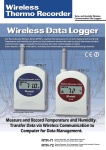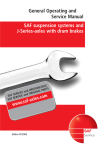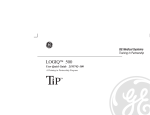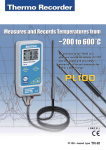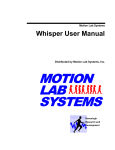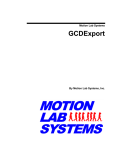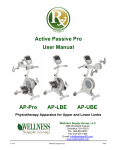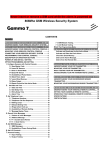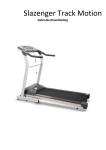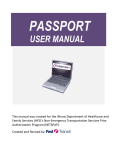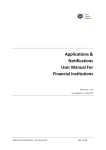Download DIFF DATA INTERFACE FILE FORMAT (DIFF) USER`S MANUAL
Transcript
DIFF DATA INTERFACE FILE FORMAT (DIFF) USER'S MANUAL
English Version / Compact version
Ver.1992.06
Clinical Gait Analysis Forum of Japan
Publication of this document was partly supported by MarubeniKikai-Boeki Co. Ltd., Japan and B.T.S., Italy.
English version is available only in compact version.
To COPY this document is ALLOWED.
When you have any questions, please contact to
Yoshihiro Ehara, Ph.D.
Rehabilitation Engineering Department
Kanagawa Rehabilitation Center
Nanasawa 516, Atsugi city, KANAGAWA 243-01, JAPAN
FAX +81-462-49-2290
2
CONTENTS
PREFACE
CHAPTER 1
3
GENERAL DESCRIPTION
6
Introduction
Form of Files
Overall Configuration of Files
Information File
Data File
Some Points of Caution when Creating Conversion Programs
CHAPTER 2
ASSIGNING A FILENAME
10
Information File
Data File
CHAPTER 3
CONTENTS OF AN INFORMATION FILE
CHAPTER 4
CONTENTS OF A DATA FILE
11
15
One Sampling Data of Floor Reaction Force Data
One Sampling Data of Space Displacement Data
for Right Limb
One Sampling Data of Space Displacement Data
for Left Limb
One Sampling Data of Space Displacement Data #2
for Right Limb
One Sampling Data of Space Displacement Data #2
for Left Limb
Appendixes are not included in the compact version.
3
PREFACE
Data Interface File Format, DIFF, is a computer file
to store time series data for Gait Analysis.
a
common
format
This is proposed as
data format to use when researchers want
to
exchange
their gait data which are measured with different systems.
It is
more
have
convenient
to
have one common format than
to
conversion
programs depend on the other party.
Because when
have
common
only
one
programs.
to
format,
we
must
have
common
format
will
format.
So
format
to one's format.
In this
be served as an intermediate
we
Format, DIFF.
restricts
we
conversion
One of which is a conversion program from one's format
the common format, and another is a conversion
the
two
many
program
way,
format
named the common format,
the
from
common
between
Data
Interface
We don't intend to have any standard format
a development of a new system.
each
Each system
File
which
can
have
any format for his own.
As
for
analysis.
DIFF there are two purposes for the
clinical
The first purpose is to construct a Data Base of
gait
the
clinical
gait analysis.
We hope the vendors and researchers
develop
at
DIFF.
And we also hope that they could send their gait data
least the conversion program from
their
to
format
to
in
DIFF to the Gait Library Center to accumulate many gait data.
If
many researchers could send us their data in DIFF, we can build a
Gait
Data Bank including a variety of age, sex, height,
way of walking and abnormalities.
We will distribute the data to
clinicians who need the data for their references.
will
This
enhance the possibility of the clinical usage of
measurement
which
system
very much.
weight,
process
the
The information
gait
file
contains the information of subjects etc., will be
of
DIFF,
served
as the management information to retrieve gait data from the data
base.
We already started the service of the Gait Library
Center
in 1992, and over 100 gait data have been accumulated so far.
4
The
second purpose of DIFF is to hold computer programs
common.
analyze
Gait
We hope the researchers to develop computer programs
gait data in DIFF, and to register the programs
to
Library Center to serve it as common properties.
application
stick
programs
picture
program,
a
distribute
analyze
have been already registered
animation
joint
program,
an
Over
moment calculation program
DIFF
gait
data.
This
process
so
also
to improve the quality of life of the patients.
library programs become sufficient, one can
a
modification
and
will
20
including
artifact
to
the
on.
these common properties to the clinician who want
clinician
the
in
We
to
help
the
When
easily
analyze
DIFF gait data without having the conversion program from DIFF to
one's format.
from
Of course a person who has the conversion
program
DIFF to his own format can analyze DIFF gait data with
his
own application programs.
DIFF
its
is written in ASCII format, so it is independent
operating system.
from
It can be used in MS-DOS, WINDOWS,
UNIX,
and Macintosh etc. Even when new OS appears, DIFF will be able to
be
used
in it.
DIFF is a format very easy
DIFF is a format very easy to be used.
to
be
understood.
It's information file can
be input directly into any commercial data base systems to
serve
as a management information such as name of the subject, date of
measurement, and name of the operator etc.
input
directly
Information
any
of
into
any
commercial
spread
file and data file can be edited and
editors and/or word processors.
gait
Its data file can be
data can be stored.
number of data.
DIFF data file.
sheet
programs.
modified
with
In DIFF data file any
There are no limitations
for
time.
time
in
Even when the sampling duration and the sampling
All
data may not be started and ended
In this way DIFF is highly flexible format to
series
the
Any data of any sampling rates can be stored
rate are different each other for each data, no problems will
happened.
kind
data for gait analysis, motion
at
be
the
store
analysis,
and
same
the
any
kinds of analysis.
5
are
The
contents of DIFF data file is device independent.
not
expressed
in output voltages etc.
Instead,
Data
data
are
expressed in the physical values such as Newtons, degrees, meters
etc.
No further calculations will be required to use DIFF
data.
The
contents of DIFF data file is Lab independent. For
example,
it does not depend on the force plates arrangements, nor it
not
depend on the 3D camera arrangement.
the
direction
coordinate
of
the walking.
The
It does not depend
positive
direction
of
is always the direction of the subject walking.
you don't have to know anything about the Lab setups.
is
does
human body oriented data.
XYZ coordinates of
on
Y
So,
DIFF
the
data
specific
points on the body in DIFF data file are not the locations of the
landmarks.
estimated
For example, XYZ coordinate of the hip joint
may
from the several landmarks around the hip joint.
be
So,
you don't have to know much about the arrangement of landmarks.
We will give you another example about the contents of
data.
kind
When we say "XYZ coordinates of the hip joint", it
of
a
we
don't know the perfect method to measure the location of the
hip
joint
some
now.
calculated.
is
However,
by
final target location to be
DIFF
So, we have to estimate the
location
by
means. One may use simple way, and the other may use
way.
the
As an extreme case, the location of the landmark fixed
skin
around
the
greater
approximation of the hip joint.
use
complicated
requested
can
be
the
We don't want to enforce you
one of the specific method.
method, because it
trochanter
It is up to you to
select
depends on your research purpose.
to describe your method somewhere.
on
first
to
the
So, it
In this
way,
are requested strictly to follow the data structure of DIFF,
is
you
but
you are not requested strictly follow the definition of each data
item.
We
have
continuously.
to
discuss
to
find
the
best
definition
DIFF might be very useful for the discussion based
on the actual gait data.
This
document
arrangement
such
describes
basic concept of
as XYZ coordinate of the
DIFF
specific
and
points
data
on
6
human
body, floor reaction forces, body segmental angles,
moment,
code
location
of center of gravity, and EMG etc.
When
a conversion program from your format to DIFF,
should
You
only
to convert data which you want to and you can convert.
For
example, if you don't have joint moment calculation program,
don't
you
you
remember that you don't have to convert all DIFF data.
have
joint
have
goniometer
to
convert
joint
moment
data.
If
system, you may convert only body
you
you
have
segmental
When you have 3D camera system, you can calculate XYZ
a
angles.
coordinate
of the landmarks and body segmental angles, but you don't have to
convert
both
calculated
all
data.
Because body segmental
angles
are
from the landmark data on DIFF data file.
So
up to you whether you convert both landmark data
easily
it
and
is
angle
data, or convert only landmark data.
DIFF was originally proposed as the common structure of
computer
data file.
So, one should strictly be followed to
described structure to convert and use DIFF file.
will
not
concept
the
of
there
is
no
segmental
We
while we are using DIFF for ever.
adequate and sufficient definition
angles so far.
his own
think
that
subject
For
for
example,
the
body
DIFF
And best definition will depend on
purpose of the measurement.
In addition to that he
prefer simple definition than complicated one.
restrict
another
Whenever better method comes up,
definition should be changed.
to
have
contents or definitions of the items should be the
discussion
the
DIFF structure
be changed in a near future. However we
for the contents of the DIFF data file.
the
So we don't
any items to only one unique definition.
It
may
want
might
disturb the development of the new method for gait analysis.
As
follows.
Base.
not
for the accuracy of DIFF data, our basic concept
One of the purpose to propose DIFF is to build
We know that if the accuracy is not sufficient,
be able to use the Data Base.
the
requirement
offer
his data.
is
a
as
Data
we
will
However we also know that
of the data accuracy is so high,
nobody
The main reason to build the Data Base
is
if
will
to
7
realize
the value of it's existence. When many people
find
its
usefulness, they will make every efforts to offer accurate
data.
So,
accuracy.
we don't want to set any standard concerning
Instead,
we request the
the
person who offer the data to
check sheet of the accuracy described in Appendix.
show
So, the
the
user
of the Data Base could refer the check sheet to find whether
the
accuracy of the data is good enough for his purpose.
As the last comment we will tell you about worldwide
format.
We
format
in EC.
oppose
each
coexistence.
features.
solve
able
other.
Instead
we
between
think
both
We may learn from each other of
can
their
the
DIFF
discussion.
data
format
come
into
check
and
period
to
having a common format is actuary useful to enhance
discuss
in
standard
distinctive
And also we need some trial
quality of life of the handicapped.
format
their
We don't think that DIFF and CAMARC
our own problems.
to
having
We will need some trial period for both to
realize that
the
know that CAMARC project is
common
After that we
whether we should have only
world.
and
Any way to
CAMARC
have
a
one
will
be
common
conversion
data file might
be
And there are no technical difficulties to do
data
program
useful
for
the
that,
so it will be done in the near future.
1994. 4. 7.
8
CHAPTER 1
GENERAL DESCRIPTION
Introduction
This
format
chapter
gives
gait
analysis.
for
the general structure
A variety
of
of
the
methods
common
have
been
considered for how to use the standard format, but we propose the
method which does not assign any limitation of each facility
each maker's format.
with
another
When the necessity arises to exchange
facility, etc., two companies would use
format proposed here as an intermediate.
can
and
a
data
common
Namely, data being sent
be converted from the sender's format to the common
format,
whereupon the receiver can convert from the common format to
own
format (herein referred to as back converting).
his
Therefore,
the common format is called as Data Interface File Format (DIFF).
This
format is applied to time sequential waveform data such
floor
reaction
statistical
force, joint angle etc., but is not
applied
data, such as average walking speed, stride
as
to
length,
and peak value of floor reaction force etc.
Form of Files
(1) Stored as text-format sequential files
(2) Alphanumerics are written in ASCII codes, however Shift JIS can
be used for comments in information files (discussed later).
(3) Information files will be created separately from data files.
Overall Configuration of Files
(1)
The gait data continuously taken in from the time
when
START button of the data collection device is pressed until
the
when
the STOP button is pressed is called one round of gait data.
(2) For each round of walking, an information file, in which
information
of
the
subject and
the
information
the
showing
the
9
conditions
of the way of walking are written, will
be
created.
The contents will be explained in the next paragraph.
(3)
For each round of walking, at least one data file, in
that
round of gait data are written, will be created.
With
later-discussed single-type data file, there will be cases
more
than
one
data
file would be created
which
for
the
where
one
round
of
walking.
(4) As mentioned above, there will be an information file and
at
least
of
one data file for each round of walking.
walking,
For n rounds
there will be n information files and at least
n
data
files.
Information File
(1) One information file is created for one round of walking.
(2)
will
As to how a filename is assigned, the first
be
assigned
etc.
the data ID, the next two characters will
in
numerics
filename
characters
be
numerics
sequence starting with 01 then incremented
to indicate the number of the trial of the
These
six
must
are
named the
consist
current
sequential
of eight characters
No.
plus
to
02,
round.
Therefore
the
the
filename
extension INF.
Example: TEST__01.INF
(3)
In this case, the data ID is a name assigned to
whole
data
which contains several trials of a given subject.
10
(4) The contents are shown on a separate sheet.
Data File
(1)
For
one trial of walking, at least one data
file
will
be
created. In some cases more than one data file will be created.
(2)
The filename will be the same as that of
the
corresponding
information file, but with a different filename extension.
This
means that the first six characters will be the data ID, the next
two
characters
with
will be numerics assigned in
sequence
01 then incremented to 02, etc. to indicate the
the trial of the current round of walking.
for the data file will be DA.
However,
later,
if
the
data file contains only
single-type
example
FRF
data, then such a file may be
data,
FRF.
arbitrary
number
of
The default file name
extension
extension
starting
as
data,
given
If the data file contains some
discussed
for
the
filename
combinations
filename extension, for example
FGE,
will
of
be
possible.
Example: D9012301.DA
(3)
D9012301.FRF
In a data file, data for
more
than one line.
TEST__01.FGE
one trial of walking
are
written
Each line is named one sampling
each element contained in the sampling data
Characters indicating the type of data
data,
is named data
enclosed in double
marks are to be set as the first item of each sampling data
and
item.
quote
(for
example, "FRF" for floor reaction force or "A1R" for joint angle,
etc.)
These are named data type code.
The second item for
each
sampling data will be the time (in seconds), and for the third up
to
a
maximum of the 32nd item, gait data will be set
orders.
These
numerical
9999.9
data
essential
items.
data
items
are
If a numerical data
will be set as a invalid data item.
Each
in
fixed
specially
item
is
called
invalid,
sampling
data
11
contains
data items which were captured at the same time.
we
one sampling data here, it means all contents
say
first
to the next CR+LF pair.
32
items,
does
to
from
character after a carriage return (CR) plus linefeed
up
the
(LF)
One sampling data may contain up
delimited by commas. In cases where a
sampling
not contain data entries for all 32 items, then -9999.9
be set after the last item as the terminator of the
data.
When
to
data
is
sampling
A sampling data can be terminated by -9999.9, if all items
after a given item are invalid.
The sampling data are to be
set
in time sequence starting with the earliest.
Example:
"FRF",0.00,
"FRF",0.01,
1.2,
0.2,
0.1,
0.1,
"FRF",0.02, 12.7, -23.2,
-0.2,-9999.9
CR+LF
40.8,-9999.9
CR+LF
69.4,-9999.9
CR+LF
"FRF",0.03, 10.2, -49.4, 113.1,-9999.9
CR+LF
"FRF",0.04, 13.4, -62.1,9999.9,-9999.9
CR+LF
etc.
etc.
etc.
etc.
"FRF",0.62,
2.3,
-0.1,
-1.2,-9999.9
CR+LF
Set -9999.9 at the last of each sampling data
Floor reaction force, vertical component
Floor
reaction
force, fore-and-aft
(in newtons)
component (in newtons)
Floor reaction force, right-left components (in newtons)
Time (in seconds)
Data type code to indicate that these are data for
floor
reaction force
CR+LF
means
JIS carriage return character and
a
JIS
linefeed
character.
9999.9 is an invalid data code.
12
(4)
When
reaction
are
different types of
data,
such
force and joint angle, each will be put on
sampling
order
there
data
does
a
as
separate
even if the time is the same, in which
not matter.
However, the time
floor
must
case
be
the
sequential
overall.
Example:
(5)
"A1R",0.00, .............
CR+LF
"FRF",0.01, .............
CR+LF
"A1R",0.01, .............
CR+LF
"FRF",0.02, .............
CR+LF
"A1R",0.02, .............
CR+LF
"A1R" data within the same file.
types
shown
other
In a
of data such as "FRF" and "A1R" and any
in
this manual can be written within one
data
other
file.
used
at
satisfied.
If
types
On
the
file,
is
Either single-type or compound-type may
the user's option, as long as the
the
file,
example
in a "FRF" file, or "A1R" data in a "A1R"
called single-type file.
"FRF"
compound-type
hand, a file contained only one type of data, for
"FRF"
be
CR+LF
The file in the above example is a compound-type with
and
all
"FRF",0.00, .............
user wishes to work
with
DIFF
rules
the
are
single-type
files, several data files and an information file can be
created
for one trial of walking.
(6)
As long as the sampling data are in time sequence,
it
does
not
matter
force
and
are in time sequence, it
does
if the sampling rates for floor reaction
joint angle are different.
(7)
As long as the sampling data
not matter if floor reaction force data starts and/or ends in the
middle
of
time sequence.
It does not matter if time
does
not
start from 0.0 sec.
13
(8)
There is no specific limit on the number of
characters
each
item
of the sampling data as long as the
data
does
not
exceed 240 bytes*.
Numeric
entire
for
sampling
values
must
have
decimal points, and exponential format is not to be used.
(9)
Spaces
may be added or not added, according to
the
user's
preference, between the delimiting comma and the next item.
(10) New data types can be added at any time as necessary.
*
This limitation comes from the limitation of
some
commercial
spread sheet programs when they read a text file into their
work
area.
Some Points of Caution when Creating Conversion Programs
(1) All data contained should be converted to a physical value.
(2)
The
coordinate
coordinate
system
is
defined
as
subject
oriented
rather than space oriented coordinate which is
to the walking path.
This means for example if the subject
and
path
returns
the
the
fore-and-aft
and
fixed
goes
right-and-left
coordinates will be reversed.
(3) The coordinate system for space displacement data must be the
same
for all measurements devices.
For example, the
system for point of application of floor reaction force and
coordinate
that
for space displacement data must be the same.
(4) The origin of the coordinates for space displacement:
origin
for
coincide
the right-and-left and the fore-and-aft axes
with
of
must
the origin of point of application of floor reaction
the force plate.
The surface of the floor is the origin
force
for
the vertical axis.
14
(5)
The
direction
of
axis
of
the
coordinates
for
space
displacement: for right-and-left right shall be positive, and for
fore-and-aft forward positive, and for vertical upward positive.
(6) Definitions of points of articulations are given in chapter4,
and details for how to attach markers to the joint and the way to
estimate the point of each articulation from markers is given
in
Appendix A1*.
(7)
Definitions of spatical angle of body segments and
angles
are given in chapter4, and details for how
to
relative
calculate
angles from coordinate data are given in Appendix A2.
(8)
The precision registration formats for floor reaction
data
as well as for 3 dimensional coordinate data are
force
given
in
Appendix A3.
* Appendixes are not included in this compact version.
CHAPTER 2
ASSIGNING A FILENAME
Information file
will
As
to how a filename is assigned, the first six
be
the data ID, the next two characters will
assigned
etc.
in
characters
be
numerics
sequence starting with 01 then incremented
to indicate the number of the trial of the
These numerics are named the sequence No.
current
to
02,
round.
Therefore the filename
must consist of eight characters plus the filename extension INF.
IDIDID01.INF
Sequential No. to indicate the number of trial
Data ID.
Example:90123A01.INF
D9412305.INF
GEORGE01.FRF
TEST__01.FGE
15
Data file
The
filename will be the same as that of the
corresponding
information file, but with a different filename extension.
IDIDID01.DA
(a case for compound-type file)
IDIDID01.FRF (a
case for single-type file, if only
FRF
is
included)
Sequential No. to indicate the number of trial
Data ID same as with an information file
For the filename extension,
file as a rule.
as
DA is used for a
compound-type
In case of single-type file, the extension
same as the data type code is used as a rule.
name
However,
any
other characters can be used for the extension if necessary.
Example:
90123A01.DA
D9412305.DA
GEORGE01.FRF
TEST__01.FGE
16
CHAPTER 3 CONTENTS OF AN INFORMATION FILE
No.
Contents
----------------------------------------------------------------1
Facility name, enclosed in double quote marks,
within 8 characters
2
Data ID, enclosed in double quote marks,
within 8 characters
3
Ex.:"TOKYO"
Patient
ID,
Ex.:"90123A"
enclosed in double
(see note 1)
quote
marks,
within
50
single-width characters (equivalent to 25 kanji characters)
4
Version number of format
Ex.:"Ver.1992.06"
(as with this version)
5
Comment A, enclosed in double
single-width
characters
(
quote
marks,
equivalent
to
within
127
254
kanji
characters)
Overall
first
comment common to multiple trials of walking.
7 bytes are to be the disability code and the next
are the disability side code.
6
Date of measurement
the
2
(see note 2)
Western date
(yr) (mo) (da)
Ex.:19910514
7
Subject's weight in kg.
Ex.: 62.3
8
Subject's height in cm.
Ex.:178.2
9
Subject's date of birth
Western date
(yr) (mo) (da)
Ex.:19620303
10
Subject's age in years old
Ex.:29.195 (see note 3)
11
Subject's gender "M" for male, "F" for female
12
Healthy or handicapped:
"ABLE" for healthy
"HANDI" for handicapped
13
Comment B, enclosed in double quote marks, within 254 singlewidth characters (equivalent to 127 kanji characters)
Comment related to the current trial of walking,
17
for example
"rapid walking"
14
Ex.:"DA_:FRF"
15
Ex.: 201
(see note 4, _ means one space character)
(number of data per channel for a FRF-type
data
in a file with the filename extension DA)
16
Ex.:"DA_:G1R"
17
Ex.: 201
(number of data per channel for a G1R-type data
in a file with the filename extension DA)
18
Ex.:"DA_:G1L"
from 14 on repeated as necessary
The above contents are to be entered delimited by commas.
CR+LF pair (hard carriage return) is not to be inserted
A
anywhere
within these contents, but is to be placed only at the end, after
the last item.
Kanji
above.
characters may be used when entering items 5
and
13
Kanji characters may also be used when entering items
3
if necessary.
Note 1:
The data ID is the filename excluding the rightmost
characters
example,
before
if
the
the
period
and
file name (not
filename
including
two
extension.
the
extension)
For
is
90123A02, then 90123A would be the data ID.
Note
2:
The
Disability
first
Code.
classification
of
7 characters of
The
comment
disability
the dysfunction according to
Independence
Measure
(FIM).
disability,
disability
code which is
the
Code
For
A
must
represents
the
the
the
Functional
subjects
the
be
main
with
cause
multiple
of
walking dysfunction should be written.
18
Disability Code
01.000
Cerebral apoplexy
01.1000
Left side paralyzed (right brain disability)
01.2000
Right side paralyzed (left brain disability)
01.3000
Both sides paralyzed
01.4000
No paralysis
01.9000
Miscellaneous cerebral apoplexy
02.000
Brain dysfunction
02.1000
Internal brain damage
02.2000
Traumatic brain damage
02.2100
Disconnection
02.2200
Nondisconnection
02.9000
03.0000
Miscellaneous brain dysfunction
Neural disorders
03.1000
Multiple sclerosis
03.2000
Parkinson's disease
03.3000
Multiple neuritis
03.4000
Guillain-Barre syndrome
03.9000
Miscellaneous neural disorders
04.0000
Spinal dysfunctions
04.1000
Internal damage
04.1100
Paraplegia
04.1110
Partial paraplegia
04.1120
Full paraplegia
04.1200
Quadriplegia
04.1211
Partial quadriplegia C1-C4
04.1212
Partial quadriplegia C5-C8
04.1221
Full quadriplegia C1-C4
04.1222
Full quadriplegia C5-C8
04.1300
Miscellaneous spinal dysfunctions from
internal damage
04.2000
Traumatic damage
04.2100
Paraplegia
04.2110
Partial paraplegia
04.2120
Full paraplegia
19
04.2200
Quadriplegia
04.2211
Partial quadriplegia C1-C4
04.2212
Partial quadriplegia C5-C8
04.2221
Full quadriplegia C1-C4
04.2222
Full quadriplegia C5-C8
04.2300
Miscellaneous spinal dysfunctions from
external damage
05.0000
Amputation
05.1000
Unilateral amputation above the elbow (AE)
05.2000
Unilateral amputation below the elbow (BE)
05.3000
Unilateral amputation above the knee (AK)
05.4000
Unilateral amputation below the knee (BK)
05.5000
Bilateral amputation both above the knee (AK/AK)
05.6000
Bilateral amputation one above, one below (AK/BK)
05.7000
Bilateral amputation both below the knee (BK/BK)
05.9000
Miscellaneous combination
06.0000
Arthritis
06.1000
Rheumatism
06.2000
Osteoarthritis
06.3000
Miscellaneous
07.0000
Pain
07.1000
Neck pain
07.2000
Back pain
07.3000
Pain in extremities
07.9000
Miscellaneous pain
08.0000
Orthopedic
08.1000
After fracture of the hip joint
08.2000
After fracture of the femur (shaft)
08.3000
After pelvic fracture
08.4000
Multiple fracture of major joint
08.5000
After total hip replacement
08.6000
After total knee replacement
20
08.9000
Miscellaneous orthopedic
09.0000
Heart disease
10.0000
Lung ailments
10.1000
Chronic obstructive lung disease
10.9000
Miscellaneous lung disorder
11.0000
Burns
12.0000
Congenital defects
12.1000
Double spine
12.9000
Miscellaneous congenital defects
13.0000
The
Miscellaneous dysfunction-causing maladies
next
2 bytes after the disability code are
the
disability
side code.
01
Right side affected
02
Left side affected
03
Both sides affected
Note
3:
number
The subject's age is indicated by the quotient
of
days difference between the year, month
of
the
and
day
measurement and the year, month and day of the subject's date
of
birth
divided by 365.25, rounded to three decimal places.
When
it
not necessary to show this so strictly, the
be
is
converted
to
an
integer for the actual number
age
of
can
years,
of
for
example, 36.0 for someone 36 years old.
Note
of
4: For item 14 and on, first write the
filename
the data file and data type code such as "DA_:FRF"
extension
and
after the delimiting comma, write the number of data per
for
that
data, not in binary, but in ASCII.
For
then
channel
example,
for
21
data
at a frequency of 50 Hz from 0.00 second to
this
number
user's option.
would be 201.
4.00
The order of the data
seconds,
type
is
the
Also, data types not measured does not need to be
written.
Example of items from 14 on :
......
"DA_:FRF",201,"DA_:G1R",201,"FRF:FRF",201,.....
Data file with the extension DA,
per channel.
FRF and G1R would have 201 data
Also, this means that data file with the
extension
FRF, FRF would have 201 data as well.
Sample of Information File
Facility name
"Tokyo",
Data ID
Patient ID
"90123A",
Comment A
"X32819A",
Date of
measurement
"05.30001...",
19910514,
Patient's (yr)(mo)(da)
of birth
Healthy or
Patient's
weight in kg.
height in cm.
64.5,
patient's
29.195,
Comment B
"Ver.1992.06",
Patient's
age
19620303,
Version No.
Type
178.20,
Patient's
gender
"M",
No. of data
handicapped
"HANDI",
"Readily...",
Type
No. of data
"DA_:G1R",
201,
"DA_:FRF",
Type
"DA_:G1l",
201
No. of data
201
CR+LF
_ means one space character.
22
CHAPTER 4 CONTENTS OF A DATA FILE
One Sampling Data of Floor Reaction Force Data
No.
Contents
Unit
---------------------------------------------------------------1
Data type
2
Time
3
FRF LR
"FRF"
seconds
component R foot (right +)
4
"
FWD
5
"
VERT component
6
"
LR
7
"
FWD
8
"
VERT component
9
"
LR
10
"
FWD
11
"
VERT component
12
component
"
(forward +)
"
"
(reaction force +)
"
component L foot (right +)
component
"
"
(forward +)
"
"
(reaction force +)
"
component LR cmb.(right +)
component
FRF point of application
"
"
(forward +)
"
"
(reaction force +)
LR
R foot
13
"
FWD
14
"
LR
15
"
FWD
16
"
LR
17
"
FWD
18
newtons(N)
"
L foot
"
"
(right +)
m
(forward +)
(right +)
"
"
(forward +)
"
LR cmb. (right +)
"
"
(forward +)
"
Torque around vert.axis
for point of appl.
R foot (opposing torque
counterclockwise as
viewed form above)
19
"
L foot (")
20
"
LR cmb.(")
21
Nm
"
"
-9999.9 (see note)
The above contents are to be entered delimited by commas.
CR+LF pair (hard carriage return) is not to be inserted
A
anywhere
within these contents, but is to be placed only at the end, after
the last item.
23
Note:
If
there is no further information to be
entered
these items, enter -9999.9 at 21st item and then a hard
beyond
carriage
return (CR+LF).
24
One Sampling data of Space Displacement Data (for Right Limb)
No.
Contents
Unit
---------------------------------------------------------------1
Data type
"G1R"
2
Time
3
Top of head
seconds
LR
(right +)
m
4
"
FWD
5
"
VERT (upward +)
6
R side
7
"
8
"
9
"
10
"
"
FWD
"
11
"
"
VERT
"
12
"
13
"
"
FWD
"
14
"
"
VERT
"
15
"
16
"
"
FWD
"
17
"
"
VERT
"
18
"
19
"
20
Acromion
(forward +)
"
"
LR
"
"
FWD
"
"
VERT
"
Hip joint
Knee joint
Ankle joint
LR
LR
"
"
"
LR
"
"
FWD
"
"
"
VERT
"
21
"
Heel
LR
"
22
"
"
FWD
"
23
"
"
VERT
"
24
"
Toe
LR
"
25
"
"
FWD
"
26
"
"
VERT
"
27
"
Ilium
LR
"
28
"
"
FWD
"
29
"
"
VERT
"
30
Metatarsus
LR
-9999.9
25
Hip joint: geometric center of the acetabulum
Knee joint: fore-and-aft and mediolateral center of the femur
at
the height of maximum fore-and-aft diameter of distal end of
the
femur in standing position
Ankle
joint:
center
point of the
line
connected
medial
and
lateral malleolus
Metatarsus:
center
point
of
the
line
connected
medial
#1
metatarsal and lateral #5 metatarsal
Toe: most forward part of the foot
The above contents are to be entered delimited by commas.
CR+LF pair (hard carriage return) is not to be inserted
A
anywhere
within these contents, but is to be placed only at the end, after
the last item.
Note:
Even
if the forward direction of walking
measurement,
the
coordinate
changes
system for the time
of
during
start
of
measurement does not change.
Note:
Origin for the vertical axis is the surface of the
floor.
The origin of fore-and-aft and right-and-left axes must
coincide
with
the
FRF,
force
plate
origin of the point of force application
measurement
data was measured simultaneously.
without
in
In case
force plate, the origin depends
on
if
of
the
user's
preference.
26
One Sampling data of Space Displacement Data (for Left Limb)
No.
Contents
Unit
---------------------------------------------------------------1
Data type
"G1L"
2
Time
3
Top of head
seconds
LR
(right +)
m
4
"
FWD
5
"
VERT (upward +)
6
L side
7
"
8
"
9
"
10
"
"
FWD
"
11
"
"
VERT
"
12
"
13
"
"
FWD
"
14
"
"
VERT
"
15
"
16
"
"
FWD
"
17
"
"
VERT
"
18
"
19
"
20
Acromion
(forward +)
"
"
LR
"
"
FWD
"
"
VERT
"
Hip joint
Knee joint
Ankle joint
LR
LR
"
"
"
LR
"
"
FWD
"
"
"
VERT
"
21
"
Heel
LR
"
22
"
"
FWD
"
23
"
"
VERT
"
24
"
Toe
LR
"
25
"
"
FWD
"
26
"
"
VERT
"
27
"
Ilium
LR
"
28
"
"
FWD
"
29
"
"
VERT
"
30
Metatarsus
LR
-9999.9
27
Hip joint: geometric center of the acetabulum
Knee joint: fore-and-aft and mediolateral center of the femur
at
the height of maximum fore-and-aft diameter of distal end of
the
femur in standing position
Ankle
joint:
center
point of the
line
connected
medial
and
lateral malleolus
Metatarsus:
center
point
of
the
line
connected
medial
#1
metatarsal and lateral #5 metatarsal
Toe: most forward part of the foot
The above contents are to be entered delimited by commas.
CR+LF pair (hard carriage return) is not to be inserted
A
anywhere
within these contents, but is to be placed only at the end, after
the last item.
Note:
Even
if the forward direction of walking
measurement,
the
coordinate
changes
system for the time
of
during
start
of
measurement does not change.
Note:
Origin for the vertical axis is the surface of the
floor.
The origin of fore-and-aft and right-and-left axes must
coincide
with
the
FRF,
force
plate
origin of the point of force application
measurement
data was measured simultaneously.
without
in
In case
force plate, the origin depends
on
if
of
the
user's
preference.
28
One Sampling data of Space Displacement Data (#2 for Right Limb)
No.
Contents
Unit
---------------------------------------------------------------1
Data type
"G2R"
2
Time
3
Top of head
seconds
LR
(right +)
m
4
"
FWD
5
"
VERT (upward +)
"
6
R side
LR
"
7
"
"
FWD
"
8
"
"
VERT
"
9
"
LR
"
10
"
"
FWD
"
11
"
"
VERT
"
12
"
13
"
"
FWD
"
14
"
"
VERT
"
15
"
16
"
"
FWD
"
17
"
"
VERT
"
18
"
19
"
"
FWD
"
20
"
"
VERT
"
21
"
22
"
"
FWD
"
23
"
"
VERT
"
24
Tragus
Acromion
Shoulder joint
Elbow joint
Wrist joint
Fingertips
(forward +)
"
LR
"
LR
"
LR
"
LR
"
-9999.9
The above contents are to be entered delimited by commas.
CR+LF pair (hard carriage return) is not to be inserted
A
anywhere
within these contents, but is to be placed only at the end, after
the last item.
Note:
Even
measurement,
if the forward direction of walking
the
coordinate
changes
system for the time
of
during
start
of
29
measurement does not change.
Note:
Origin for the vertical axis is the surface of the
floor.
The origin of fore-and-aft and right-and-left axes must
coincide
with
the
FRF,
force
plate
origin of the point of force application
measurement
data was measured simultaneously.
without
in
In case
force plate, the origin depends
on
if
of
the
user's
preference.
30
One Sampling data of Space Displacement Data (#2 for Left Limb)
No.
Contents
Unit
---------------------------------------------------------------1
Data type
"G2L"
2
Time
3
Top of head
seconds
LR
(right +)
m
4
"
FWD
5
"
VERT (upward +)
"
6
L side
LR
"
7
"
"
FWD
"
8
"
"
VERT
"
9
"
LR
"
10
"
"
FWD
"
11
"
"
VERT
"
12
"
13
"
"
FWD
"
14
"
"
VERT
"
15
"
16
"
"
FWD
"
17
"
"
VERT
"
18
"
19
"
"
FWD
"
20
"
"
VERT
"
21
"
22
"
"
FWD
"
23
"
"
VERT
"
24
Tragus
Acromion
Shoulder joint
Elbow joint
Wrist joint
Fingertips
(forward +)
"
LR
"
LR
"
LR
"
LR
"
-9999.9
The above contents are to be entered delimited by commas.
CR+LF pair (hard carriage return) is not to be inserted
A
anywhere
within these contents, but is to be placed only at the end, after
the last item.
Note:
Even
measurement,
if the forward direction of walking
the
coordinate
changes
system for the time
of
during
start
of
31
measurement does not change.
Note:
Origin for the vertical axis is the surface of the
floor.
The origin of fore-and-aft and right-and-left axes must
coincide
with
the
FRF,
force
plate
origin of the point of force application
measurement
data was measured simultaneously.
without
in
In case
force plate, the origin depends
on
if
of
the
user's
preference.
32
One Sampling Data of Spatial Angle for Body Segment
No.
Contents
Unit
---------------------------------------------------------------1
Data type
2
Time
3
Head
"S1B"
seconds
Fore-and-aft leaning angle (back +)
4
"
LR bending angle
5
"
LR rotation angle
6
Abdomen
degrees
(left +)
"
(left +)
"
same as above
"
7
"
"
"
8
"
"
"
"
"
9
Pelvis
10
"
"
"
11
"
"
"
12
-9999.9
The above contents are to be entered delimited by commas.
CR+LF pair (hard carriage return) is not to be inserted
A
anywhere
within these contents, but is to be placed only at the end of the
line, after the last item.
The
spatial angle of a body segment is the
relative
angle
formed between the coordinate system for the walking path and the
coordinate
for
system for the body segment.
The
coordinate
the walking path is fixed coordinate system for
the
system
waling
path, and the coordinate systems for the body segment are
fixed-
coordinate systems for each respective body segment.
The
spatial angle is defined for the right limb
coordinate
a) the angle from the vertical axis as viewed from the right-hand
plane
as
the
in sagittal plane,
b) the angle from the horizontal
viewed from the rear in transverse plane,
c) the angle
axis
from
forward axis as viewed from above, with counterclockwise
as
positive.
33
For
the left limbs, a) the angle from the vertical axis
viewed from the left-hand plane in sagittal plane,
b) the
from
in
the horizontal axis as viewed from the rear
plane,
as
angle
transverse
c) the angle from the forward axis as viewed from
above,
with clockwise as positive.
For convenience, the coordinate system for the left limb
is
also to be used for the trunk.
34


































